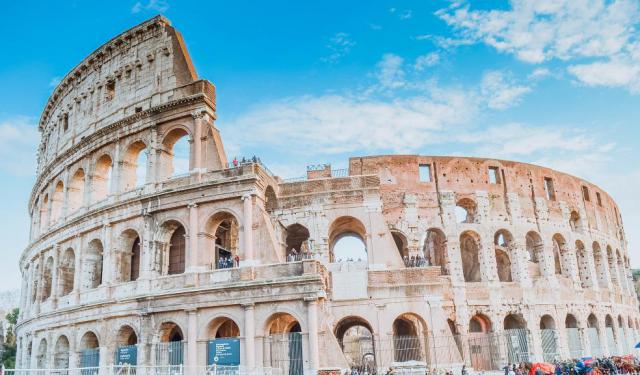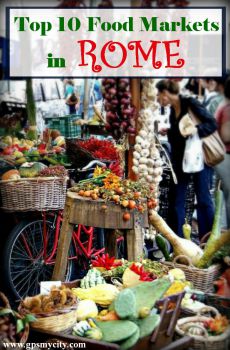Tempio del Divo Giulio (Temple of Deified Julius), Rome
The Temple of Deified Julius, also called the Temple of Caesar, is a significant monument in the Roman Forum, built to honor Julius Caesar. Situated near the Regia and Temple of Vesta, it once stood as the focal point of the Forum, symbolizing the power of the emerging Roman Empire.
Although Julius Caesar was never officially an emperor-that title went to his adopted son Augustus-his actions led to the Republic’s collapse. His appointment as dictator for life alarmed the Roman aristocracy and ultimately led to his assassination. The ensuing political turmoil resulted in the rise of the Empire. The temple was part of this transition, reinforcing the new regime’s authority. Many who had supported Caesar’s murder later backed the temple’s construction, likely to align themselves with the public’s admiration for him.
Caesar became the first Roman to be deified after death and the first to be buried in the Forum. His cremation in 44 BC was spontaneous, happening in the Forum rather than the planned Field of Mars. Given that Roman laws prohibited burials within city limits for hygienic reasons, this was an exceptional honor. A temporary shrine soon emerged at the cremation site, drawing widespread public devotion. Recognizing the significance of Caesar’s deification, the Senate officially decreed the temple in 42 BC, and Augustus dedicated it on August 18, 29 BC.
The temple became a central political and religious landmark. Its high podium doubled as a speaker’s platform, decorated with ship prows taken as war trophies. It hosted imperial speeches, funerary eulogies, and political declarations, further cementing Augustus’s connection to his divine predecessor. A festival in Augustus’s honor was held here every four years, reinforcing his status.
Architecturally, the temple mirrored the Temple of Venus Genetrix, emphasizing the Julian family’s divine lineage. Scholars debate whether its columns followed Corinthian, Ionic, or Composite styles. A key symbol of Caesar’s deification was Caesar’s Comet, which appeared for seven days after his death. Augustus seized on this celestial event, using it to promote Caesar’s divine status and incorporating a star motif into the temple’s decoration.
By the 15th century, much of the temple’s materials had been repurposed for other buildings, leaving only cement foundations. Today, it remains a historically significant site, with visitors still leaving offerings at Caesar’s altar, especially on March 15, the anniversary of his assassination.
Although Julius Caesar was never officially an emperor-that title went to his adopted son Augustus-his actions led to the Republic’s collapse. His appointment as dictator for life alarmed the Roman aristocracy and ultimately led to his assassination. The ensuing political turmoil resulted in the rise of the Empire. The temple was part of this transition, reinforcing the new regime’s authority. Many who had supported Caesar’s murder later backed the temple’s construction, likely to align themselves with the public’s admiration for him.
Caesar became the first Roman to be deified after death and the first to be buried in the Forum. His cremation in 44 BC was spontaneous, happening in the Forum rather than the planned Field of Mars. Given that Roman laws prohibited burials within city limits for hygienic reasons, this was an exceptional honor. A temporary shrine soon emerged at the cremation site, drawing widespread public devotion. Recognizing the significance of Caesar’s deification, the Senate officially decreed the temple in 42 BC, and Augustus dedicated it on August 18, 29 BC.
The temple became a central political and religious landmark. Its high podium doubled as a speaker’s platform, decorated with ship prows taken as war trophies. It hosted imperial speeches, funerary eulogies, and political declarations, further cementing Augustus’s connection to his divine predecessor. A festival in Augustus’s honor was held here every four years, reinforcing his status.
Architecturally, the temple mirrored the Temple of Venus Genetrix, emphasizing the Julian family’s divine lineage. Scholars debate whether its columns followed Corinthian, Ionic, or Composite styles. A key symbol of Caesar’s deification was Caesar’s Comet, which appeared for seven days after his death. Augustus seized on this celestial event, using it to promote Caesar’s divine status and incorporating a star motif into the temple’s decoration.
By the 15th century, much of the temple’s materials had been repurposed for other buildings, leaving only cement foundations. Today, it remains a historically significant site, with visitors still leaving offerings at Caesar’s altar, especially on March 15, the anniversary of his assassination.
Want to visit this sight? Check out these Self-Guided Walking Tours in Rome. Alternatively, you can download the mobile app "GPSmyCity: Walks in 1K+ Cities" from Apple App Store or Google Play Store. The app turns your mobile device to a personal tour guide and it works offline, so no data plan is needed when traveling abroad.
Tempio del Divo Giulio (Temple of Deified Julius) on Map
Sight Name: Tempio del Divo Giulio (Temple of Deified Julius)
Sight Location: Rome, Italy (See walking tours in Rome)
Sight Type: Attraction/Landmark
Guide(s) Containing This Sight:
Sight Location: Rome, Italy (See walking tours in Rome)
Sight Type: Attraction/Landmark
Guide(s) Containing This Sight:
Walking Tours in Rome, Italy
Create Your Own Walk in Rome
Creating your own self-guided walk in Rome is easy and fun. Choose the city attractions that you want to see and a walk route map will be created just for you. You can even set your hotel as the start point of the walk.
Rome Shopping Streets Walking Tour
Loved by tourists for its busy fashionable streets and significant baroque icons, the so-called ‘Tridente’ is one of the Eternal City's most lusted-after areas, formed by Via dei Condotti, Via Borgognona, Via Frattina and the adjacent Via del Corso. It is perhaps the most high-end destination for Roman shopping, with a concentration of renowned jewelers and important Italian/international... view more
Tour Duration: 2 Hour(s)
Travel Distance: 2.9 Km or 1.8 Miles
Tour Duration: 2 Hour(s)
Travel Distance: 2.9 Km or 1.8 Miles
Trastevere Walking Tour
Heading down from the Vatican along the River Tiber, one is bound to find yet another city hidden within the city – Trastevere. This name translates literally to "across the Tiber". Indeed, crossing the picturesque Ponte Sisto (Sisto Bridge) to the west bank, you will find yourself in a charming neighborhood with a distinct character that sets it apart from any other part of Rome.
... view more
Tour Duration: 2 Hour(s)
Travel Distance: 3.0 Km or 1.9 Miles
... view more
Tour Duration: 2 Hour(s)
Travel Distance: 3.0 Km or 1.9 Miles
Palatine Hill Walking Tour
Palatine Hill — one of Rome’s legendary Seven Hills — is the most ancient part of the city. According to mythology (and a fair bit of archaeology backing it up), this is where the whole Roman saga began to unfold in the year 753 BC when young Romulus pointed dramatically at the hill and probably thought to himself: “Yes, this is the spot.” And just like that, a city that would eventually... view more
Tour Duration: 2 Hour(s)
Travel Distance: 2.6 Km or 1.6 Miles
Tour Duration: 2 Hour(s)
Travel Distance: 2.6 Km or 1.6 Miles
Roman Forum and Imperial Forums Walking Tour
t's a known fact that Rome wasn't built in a day. But since it was built, the city has stood the test of time and become "eternal." A popular proverb says, "all roads lead to Rome," but very few realize that, inside Rome itself, all roads lead to the Forum.
Indeed, the central hub of ancient Rome, the Roman Forum and the Imperial Forums once served as the... view more
Tour Duration: 2 Hour(s)
Travel Distance: 2.0 Km or 1.2 Miles
Indeed, the central hub of ancient Rome, the Roman Forum and the Imperial Forums once served as the... view more
Tour Duration: 2 Hour(s)
Travel Distance: 2.0 Km or 1.2 Miles
Holy Sites Walking Tour
As the cradle of the Catholic Church, one of the world's largest organizations, Rome has a large number of valuable, sacred places of worship. Crowded with architectural splendors from different periods of time, each of its churches and basilicas represent a significant part of culture and history.
Take this self-guided walking tour to discover Rome's magnificent religious heritage,... view more
Tour Duration: 3 Hour(s)
Travel Distance: 6.9 Km or 4.3 Miles
Take this self-guided walking tour to discover Rome's magnificent religious heritage,... view more
Tour Duration: 3 Hour(s)
Travel Distance: 6.9 Km or 4.3 Miles
Rome Introduction Walking Tour I
Often referred to as the Eternal City, Rome holds a unique place in the story of Western civilization. Its influence shaped European culture through language, governance, and monumental architecture.
The name “Rome” originates from Romulus, the mythical founder of the city, who, according to legend, was the son of the war god Mars and Rhea Silvia, the priestess of goddess Vesta. Both... view more
Tour Duration: 2 Hour(s)
Travel Distance: 3.7 Km or 2.3 Miles
The name “Rome” originates from Romulus, the mythical founder of the city, who, according to legend, was the son of the war god Mars and Rhea Silvia, the priestess of goddess Vesta. Both... view more
Tour Duration: 2 Hour(s)
Travel Distance: 3.7 Km or 2.3 Miles
Useful Travel Guides for Planning Your Trip
17 Best Gelaterias in Rome Italy
For ice cream lovers and dabblers this guide is a treasure chest of Rome’s best gelato shops. There are gelaterias everywhere. Many visitors to Rome only have a few days to explore the city. You owe it to yourself to make the most of your time and find the gelato locals eat. Often the authentic...
10 Best Food Markets in Rome Italy
Of all the things Italy is most famous for (cars, music, fashion, movies, etc.), food is, undoubtedly, top of the list. Rome may well not be the whole Italy, but no Italy is whole without Rome... And the Romans, much as all their fellow-Italians, like it "fresco", hence the abundance of...
Souvenirs Shopping: 15 Authentic Italian Things To Buy in Rome
Rome is the Eternal City and, as such, the list of gift options available here is countless. Whether it's something edible, drinkable, wearable or pleasing to the eye that you want - you will find it all here in abundance. However, if time or budget is the factor, perhaps you might want to...












